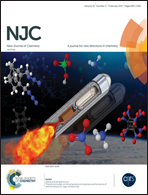Ionization characteristics of glycosides by direct analysis in real time quadrupole-time of flight mass spectrometry†
Abstract
Glycosides, which are widely distributed in many plants, possess numerous biological activities. Direct analysis in real time (DART) allows the rapid analysis of samples or objects in their native state in the open environment. The ionization characteristics of glycosides by DART, however, have not yet been investigated in detail. DART quadrupole-time of flight mass spectrometry (DART-Q-TOF-MS) was developed to investigate the ionization characteristics of different kinds of glycosides in both positive and negative ion modes. All the glycosides were ionized via various different reactions including (de)protonation, molecular ion formation, ISD fragmentation, and the formation of adducts. In contrast, glycosidic cleavage ions and molecular ions (radical ions) were easily detected in negative DART mass spectra by the capture of an electron. The degree of glycosidic cleavage varied with the structural properties of individual glycosides, which were substantiated by theoretical calculations using the software package Gaussian 09. Temperature and types of DART gas played important roles in DART mass spectrometric analysis of glycosides.



 Please wait while we load your content...
Please wait while we load your content...